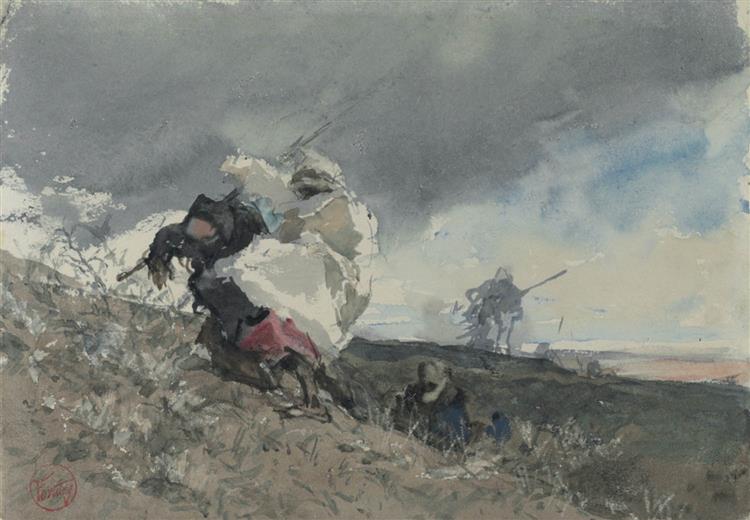Description
The work "Arab walking in the storm" by Mariano Fortuny is an excellent example of the way in which the Spanish artist captures the vibrant atmosphere of North Africa through his unmistakable orientalist style. Although it is a painting marked by action, the title itself suggests a deeper narrative, hinting at the movement of the characters in an adverse environment that, in turn, evokes both the force of nature and human resilience.
The first aspect that stands out in the work is its composition, which shows a group of Arabs in full contest with an imminent storm. The scene is carefully structured, with the characters located in a diagonal that guides the viewer's look from one side to another, creating a dynamic sensation. Fortuny captures the contrast between the fragility of the human being and the imposing force of the elements, representing the walkers with a movement that suggests both determination and struggle.
The color palette used by Fortuny is another essential point of the work. The dark and gloomy tones of the sky are mixed with the vibrant colors of the characters' clothing, creating a dramatic contrast. The intense red and blue of the outfits become almost symbols of hope in the face of climatic adversity, while the threatening clouds in the background seem to represent desolation. This use of color not only establishes the emotional tone of painting, but also stands as a testimony of Fortuny's domain over the technique of chiaroscuro, which gives the work a depth and almost palpable visual intensity.
The characters are the true protagonists of this canvas, whose expressions and poses convey a narrative of struggle and sacrifice. Dresses with traditional costumes, each of them is a representation of Arab culture, which aligns with the eastern approach that interested the artist so much during his career. Fortuny manages to humanize these travelers through the individuality of their physical characteristics and their gestures, suggesting that, despite the hostile environment that surrounds them, there is a history of resistance and spirit in each figure.
The context of the work also deserves mention. Fortuny, who had a deep interest in the cultures of North Africa, spent time in Morocco, where he was able to capture the essence of the landscape and the daily life that surrounded him. This trip not only enriched his palette but also pushed him to explore less conventional themes in the painting of his time, opening a visual dialogue about expectation and reality, the exotic and the everyday.
"Arab walking in the storm" is inscribed within a broader tradition in which many artists of the nineteenth century looked towards the East in search of inspiration. Fortuny's work can be compared to that of other contemporary artists such as Eugène Delacroix or Jean-Léon Gérôme, who also explored the orientalist theme, although with differences in their approach and technique. Fortuny's ability to build atmospheres and transmit emotions through subtle details and an almost photographic approach in the collection of light distinguishes him in this field.
In conclusion, "Arabs walking in the storm" is not only a representation of a precise moment, but an exploration of the relationship between man and nature, between culture and the environment. Mariano Fortuny achieves, with mastery, to capture the essence of struggle and resistance, turning his characters into symbols of a broader experience and, at the same time, intimate. This painting, loaded with visual and theoretical emotions, remains a testimony of the talent and vision of one of the greatest exponents of Spanish art of the nineteenth century.
KUADROS ©, a famous paint on your wall.
Hand-made oil painting reproductions, with the quality of professional artists and the distinctive seal of KUADROS ©.
Art reproduction service with satisfaction guarantee. If you are not completely satisfied with the replica of your painting, we refund your money 100%.

